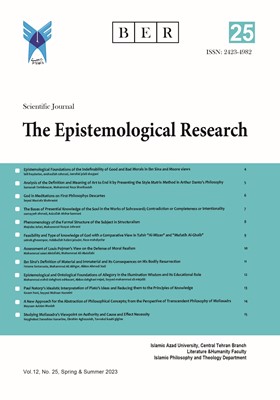Analysis of the Definition and Meaning of Art to End it by Presenting the Style Matrix Method in Arthur Danto's Philosophy
Subject Areas : Epistemological researches
Samaneh Tariabouzar
1
,
Mohammad Reza Sharifzadeh
2
![]()
1 - Philosophy of Art Department, Art Faculty, Islamic Azad University, Central Tehran Branch, Tehran, Iran
2 - Professor of Department of Philosophy of Art, Faculty of Art, Islamic Azad University, Central Tehran Branch
Keywords: Definition of Art, Style Matrix, End of Art, Arthur Danto,
Abstract :
The definition and meaning of the artwork have been accompanied by various ups and downs throughout history and philosophers' opinions about the nature of art have been different and antithetic. But in the contemporary era, our epistemological access to the meaning of art has expanded and become more precise, and the meaning of the artwork is partly determined by its historical context. Accordingly, Hegel's historicism allows us to change the meaning of the artwork with the evolution of art history. The main purpose of the research is to analyze the theories of Arthur Danto and his attempt to define art and the end of art. Danto initially proposed what he called the Style Matrix to explain the meaning of art, but later rejected it and replaced it with historicism. Art philosophy is closely tied to art history. The main question of the article is: How art is specified by definition? And if art embodies a meaning, what characteristics will it have in the world after the end of art? The result of this research, which is descriptive-analytical and based on library data, shows that: by tracing the history and philosophy of art from the beginning to the present century, Danto tried to simplify his definition of art into two principles: 1) art must have content or meaning, 2) art must embody that meaning in an appropriate way. And finally, by announcing the end of art, he reached a new understanding of art in the post-historic era.
اسفندیاری، آپهنا- آیتاللهی، حبیبالله .(1389). ملاحظات انتقادی تاریخ هنر در تحلیل تاریخ سنتی هنر. فصلنامه نامه هنرهای تجسمی و کاربردی، شماره 5، 118-131.
دیویس، استیفن .(1385). چالشهای تعریف هنر. محمد حامی، نشریه رواق هنر و اندیشه، شماره 2، 46-63.
شریفزاده، محمدرضا- بنی اردلان، اسماعیل .(1392). تحلیل فلسفی در نظریة عالم هنر آرتور دانتو. دوفصلنامه فلسفی شناخت، شماره 1/69، 95-126.
نصری، سمیه- مرادخانی، علی .(1400). بازنمایی به منزلة معنای مجسم از دیدگاه آرتور دانتو (مطالعه موردی آثار جف کونز). فصلنامه حکمت و فلسفه، شماره 65، 159-179.
ونینگر، رجینا. (1389). سبک فردی پس از پایان هنر. سید جواد فندرسکی- شادی حدادپور خیابان، نشریه اطلاعات حکمت و معرفت، شماره 5، 37-40.
Andina, Tiziana. (2011). Arthur Danto: Philosopher of Pop. Cambridge Scholars Publishing, First Published.
Bacharach, Sondra. (2022). The Style Matrix. A Companion to Arthur C. Danto, John Wiley Publisher, 248-255.
Boardman, Frank. (2015). Back in Style: A New Interpretation of Danto’s Style Matrix. The Journal of Aesthetics and Art Criticism, No 73:4, 441-448.
Bordonado, Laure. (2016). Arthur C. Danto or the Duality of Worlds. Book and Ideas, No 33, 1-9.
Cascales, Raquel. (2019). Arthur Danto and the End of Art. Cambridge Scholars Publishing, First Published.
Danto, Arthur Coleman. (1964). The Artworld. The Journal of American Philosophical Association, No 19, 571-584.
Danto, Arthur Coleman. (1998). The End of Art: A philosophical Defense. Wiley Blackwell Publishing for Wesleyan University, No 4, 127-143.
Danto, Arthur Coleman. (2007). Embodied Meanings, Isotypes, and Aesthetical Idea. The Journal of Aesthetics and Art Criticism, No 65, 121-129.
Vandevert, John. (2020). The Theoretical Usage of Danto's Style Matrix in the redefinition of Hip-Hop. University of Bristol, No 90, 13-28.
_||_

